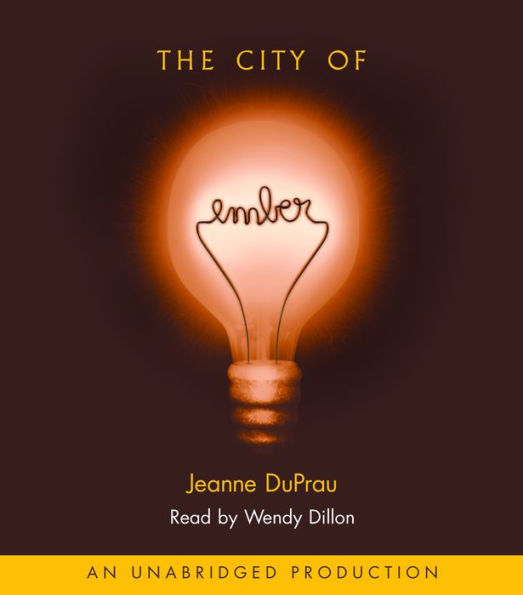OCT/NOV 04 - AudioFile
A post-apocalyptic chain of events has left the city of Ember facing food shortages, citizen riots, and rolling blackouts. Their light source is beginning to fail, and the domed city protecting the remaining humans on Earth seems doomed. Twelve-year-olds Lina and Doon believe salvation will come only from an ancient scrap of paper they found with "Instructions for Egress." The two set off on a dangerous journey into the dark, unknown world beyond their city. Wendy Dillon’s rich, throaty tones describing Ember’s domescape are gloomily impeccable. She slips in and out of preadolescent voices with ease and manages to create an atmosphere of hope in the midst of desolation. THE CITY OF EMBER is Jeanne DuPrau’s first novel for a middle-school audience. THE PEOPLE OF SPARKS continues the tale. S.J.H. © AudioFile 2004, Portland, Maine
Publishers Weekly
In her electric debut, DuPrau imagines a post-apocalyptic underground world where resources are running out. The city of Ember, "the only light in the dark world," began as a survival experiment created by the "Builders" who wanted their children to "grow up with no knowledge of a world outside, so that they feel no sorrow for what they have lost." An opening prologue describes the Builders' intentions-that Ember's citizens leave the city after 220 years. They tuck "The Instructions" to a way out within a locked box programmed to open at the right time. But the box has gone astray. The story opens on Assignment Day in the year 241, when 12-year-olds Lina Mayfleet and Doon Harrow draw lots for their jobs from the mayor's bag. Lina gets "pipeworks laborer," a job that Doon wants, while Doon draws "messenger," the job that Lina covets, and they trade. Through their perspectives, DuPrau reveals the fascinating details of this subterranean community: as Doon repairs leaks deep down among the Pipeworks, he also learns just how dire the situation is with their malfunctioning generator. Meanwhile, the messages Lina carries point to other sorts of subterfuge. Together, the pair become detectives in search of the truth-part of which may be buried in some strange words that were hidden in Lina's grandmother's closet. Thanks to full-blooded characters every bit as compelling as the plot, Lina and Doon's search parallels the universal adolescent quest for answers. Readers will sit on the edge of their seats as each new truth comes to light. Ages 10-13. (May) Copyright 2003 Reed Business Information.
School Library Journal
Gr 4-7-DuPrau debuts with a promisingly competent variation on the tried-and-true "isolated city" theme. More than 200 years after an unspecified holocaust, the residents of Ember have lost all knowledge of anything beyond the area illuminated by the floodlamps on their buildings. The anxiety level is high and rising, for despite relentless recycling, food and other supplies are running low, and the power failures that plunge the town into impenetrable darkness are becoming longer and more frequent. Then Lina, a young foot messenger, discovers a damaged document from the mysterious Builders that hints at a way out. She and Doon, a classmate, piece together enough of the fragmentary directions to find a cave filled with boats near the river that runs beneath Ember, but their rush to announce their discovery almost ends in disaster when the two fall afoul of the corrupt Mayor and his cronies. Lina and Doon escape in a boat, and after a scary journey emerge into an Edenlike wilderness to witness their first sunrise-for Ember, as it turns out, has been built in an immense cavern. Still intent on saving their people, the two find their way back underground at the end, opening the door for sequels. The setting may not be so ingeniously envisioned as those of, say, Joan Aiken's Is Underground (Turtleback, 1995) and Lois Lowry's The Giver (Houghton, 1993), but the quick pace and the uncomplicated characters and situations will keep voracious fans of the genre engaged.-John Peters, New York Public Library Copyright 2003 Reed Business Information.
Kirkus Reviews
This promising debut is set in a dying underground city. Ember, which was founded and stocked with supplies centuries ago by "The Builders," is now desperately short of food, clothes, and electricity to keep the town illuminated. Lina and Doon find long-hidden, undecipherable instructions that send them on a perilous mission to find what they believe must exist: an exit door from their disintegrating town. In the process, they uncover secret governmental corruption and a route to the world above. Well-paced, this contains a satisfying mystery, a breathtaking escape over rooftops in darkness, a harrowing journey into the unknown and cryptic messages for readers to decipher. The setting is well-realized with the constraints of life in the city intriguingly detailed. The likable protagonists are not only courageous but also believably flawed by human pride, their weaknesses often complementing each other in interesting ways. The cliffhanger ending will leave readers clamoring for the next installment. (Fiction. 9-13)
OCT/NOV 04 - AudioFile
A post-apocalyptic chain of events has left the city of Ember facing food shortages, citizen riots, and rolling blackouts. Their light source is beginning to fail, and the domed city protecting the remaining humans on Earth seems doomed. Twelve-year-olds Lina and Doon believe salvation will come only from an ancient scrap of paper they found with "Instructions for Egress." The two set off on a dangerous journey into the dark, unknown world beyond their city. Wendy Dillon’s rich, throaty tones describing Ember’s domescape are gloomily impeccable. She slips in and out of preadolescent voices with ease and manages to create an atmosphere of hope in the midst of desolation. THE CITY OF EMBER is Jeanne DuPrau’s first novel for a middle-school audience. THE PEOPLE OF SPARKS continues the tale. S.J.H. © AudioFile 2004, Portland, Maine



